Types of Purple Flowering Vines: Climbing Vines With Their Picture and Name
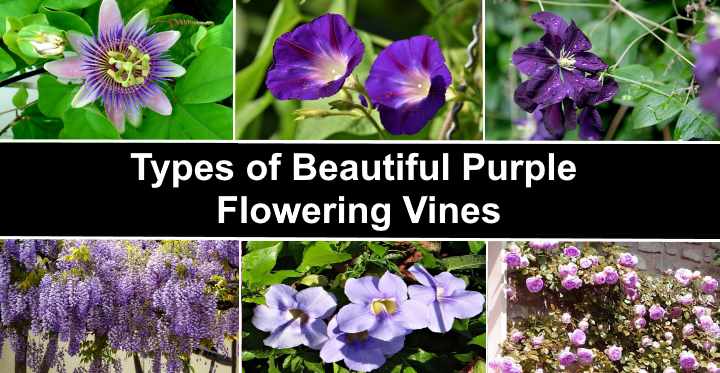
Purple flowering vines add dramatic color to many garden landscapes. Climbing vines with purple flowers are generally easy to grow and need little care. You can plant climbing plants in your garden to grow over trellises, arbors, pergolas, brick walls, or doorways. Their lilac, mauve, light violet, or purple colors provide plenty of interest in your yard when the climbing vines bloom.
There are many climbing perennials to choose from with flowers that bloom year after year. Usually, these purple flowering vines have evergreen foliage useful for keeping your garden looking green throughout winter. Some types of purple vining plants, such as sweet pea or hyacinth bean vines, are annuals. So, you must plant these climbers every year to enjoy their purple flowers.
In this article, you will learn about the best purple flowering vines for your garden. You’ll find pictures of these beautiful creeping plants and information about where to grow these vines and how to care for them.
Where to Plant Flowering Vines
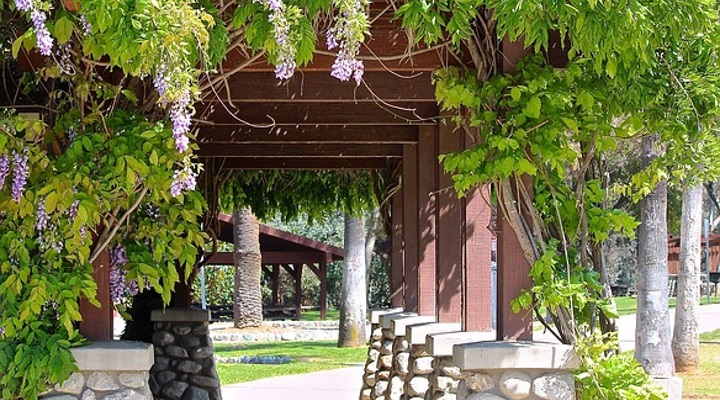
Flowering climbing plants are a great addition to any garden landscape
Climbing plants have many uses in your garden landscape. To create the desired effect, it’s vital to choose the right type of climbing vine. However, flowering vines are useful for growing up fences and walls, creating backdrops for flower beds, or covering garden eyesores such as compost pile shelters. Some trailing plants can be trained to grow up on posts, arbors, or trellises.
Here are some uses for growing fragrant, flowering vines in your yard:
Flowering vines for living fences are ideal for growing on chain link, chicken wire, or wooden fences. Flowering creepers such as hyacinth bean, morning glory, clematis, and honeysuckle can cover fences with purple flowers throughout the summer.
Climbing vines for walls can grow up brick or stone walls to cover structures with beautiful purple flowers and lush green foliage. Climbing plants such as wisteria, honeysuckle, Boston ivy, and clematis have suckers that stick to walls.
Creeper plants can be used as climbing plants or ground cover vines. Rather than grow upward, you can let some vining plants spread over the ground. Planting flowering vines such as climbing roses, honeysuckles, and clematis plants can quickly cover bare ground to make your garden bloom in summer.
Types of Purple Vining Plants
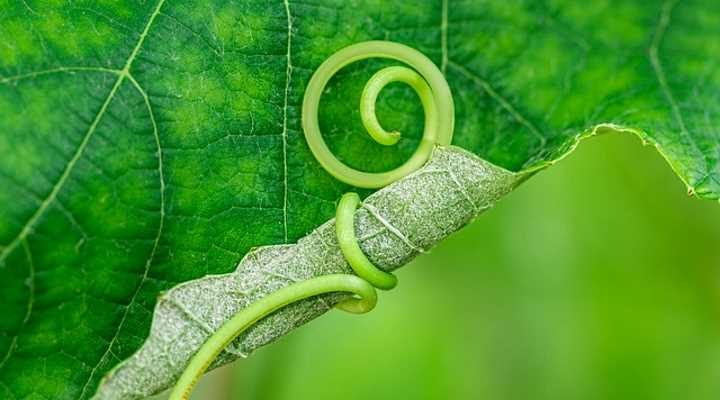
A close up picture of tendril grapevine
When choosing the right type of outdoor flowering purple vines, it’s vital to pick the right kind. Plants with long, trailing stems have various methods of climbing or creeping. Here is a brief overview of vine types:
- Clinging vines—These vining plants have roots or suckers that cling to surfaces such as walls, wooden structures, bricks, and stones.
- Twining vines—These trailing plants are suitable for wrapping their vines around poles, trellises, pergolas, and arbors.
- Tendril vines—The vines on tendril plants have small shoot-like structures called tendrils that cling on to anything possible.
The Best Purple Flowering Vines (With Pictures) – Identification Guide
Let’s look in more detail at the most spectacular types of climbing plants with purple flowers that you can grow as vines in your front or back yard.
Purple Clematis Vine
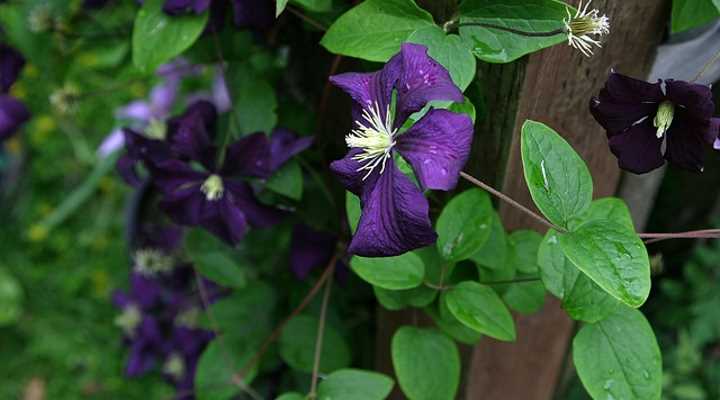
Clematis is a vining plant with various shades of purple flowers as well as other colors
Clematis is a climbing vine with beautiful star-shaped single or double flowers. As a fast-growing climber, clematis quickly grows up walls, arbors, or poles. Purple clematis vine flowers have shades of purple that range from light lilac to deep purple. Clematis flowers can be large with multi-colored petals or small with dangling bell-shaped blooms.
Clematis vines grow around 10 ft. (3 m) tall and thrive in full sun or partial shade. The vigorous vine clings to structures using tendrils. Clematis vines grow as perennials in warmer climates but as annuals in northern regions.
Purple Vining Roses (Rosa)

There are beautiful varieties of rose hybrids and cultivars to use as garden climbers
Vining roses are climbing plants that have long woody stems that can be trained to climb. The beautiful purple, light pink, or lilac rose flowers bloom through the summer, adding colorful height accents to your garden landscape. Climbing purple roses are perfect for growing over arbors or gate entrances to beautify your garden.
To encourage roses to climb, support the arching canes as they grow. The long, stretching stems or canes can grow up to 10 ft. (3 m) tall. Plant vining roses in full sun where they thrive in USDA zones 5 through 9. During summer, water roses enough to prevent the soil from completely trying out.
Purple Hyacinth Bean Vine (Lablab purpureus)
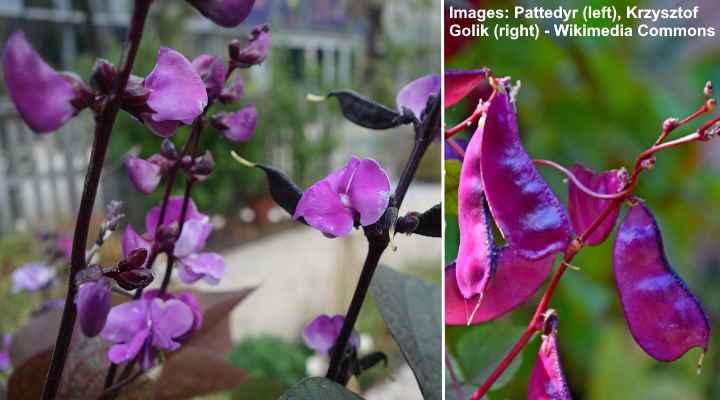
Hyacinth bean vine has delicate purple flowers (left) and shiny purple seed pods (right)
Purple hyacinth bean vines are annuals with purplish leaves, dark stems, purple flowers, and showy purple seeds. Hyacinth flowers look like purple sweet peas when in bloom, then followed by glossy purple seed pods. The stunning vining plant grows quickly to cover chain fences, walls, climb up pergolas, or create flowering canopies.
Purple hyacinth bean vines grow between 10 and 20 ft. (3 – 6 m) if you give the trailing stems support. Hyacinth vines grow best in full sun and well-draining soil that is kept moist. This heat-loving climbing plant only grows in USDA zones 9 through 11.
Purple Flowering Passion Vines (Passiflora)
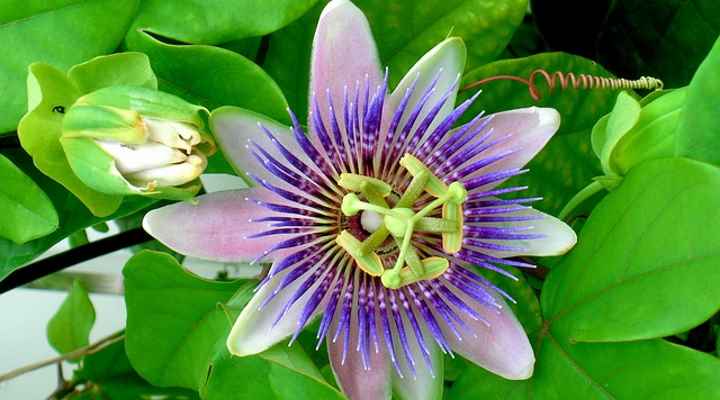
Passiflora is a flowering vine with stunning purple flowers that thrives in full sun
Passion vines are tropical climbing garden vines with spectacular purple and lilac flowers and semi-evergreen foliage. The eye-catching features of passion flowers are their purple petals, wispy corona filaments, and unusual stigmas. Passion vines grow best on trellises, arbors, or fences. Passion vines climb by their tendrils attaching to surfaces.
Passion vines grow best in warmer climates in zones 7 through 11. Growing in full sun and well-drained soil, the long vines can reach 20 or 30 ft. (6 – 9 m) in length. However, the vines usually die back to the ground in winter and return to flower the following spring.
Blue Sky Vine (Thunbergia grandiflora)

Blue sky vine has attractive pale purple flowers and grows as a perennial climber in warmer climates
Sky vine is a tropical twining flowering vine with funnel-shaped clusters of lavender-blue flowers and heart-shaped green leaves. The sky vine’s vigorous growth and long wandering tendrils make the climbing vine perfect for decorating trellises, arbors, or covering unsightly fences. The attractive purple flowers on sky vines bloom in late summer.
Sky vines grow as perennials in warmer climates and annuals in colder regions. In one season, the fast-growing climbing plant can grow up to 8 ft. (2.4 m) in length. As a perennial in tropical areas, sky vines grow around 30 ft. (9 m) tall.
Blue sky vines also grow well in containers or flowering hanging baskets. Growing the potted vine plants this way, you can enjoy their pretty blue or purple flowers all year long.
Purple Flowering Lavender Trumpet Vine (Clytostoma callistegioides)
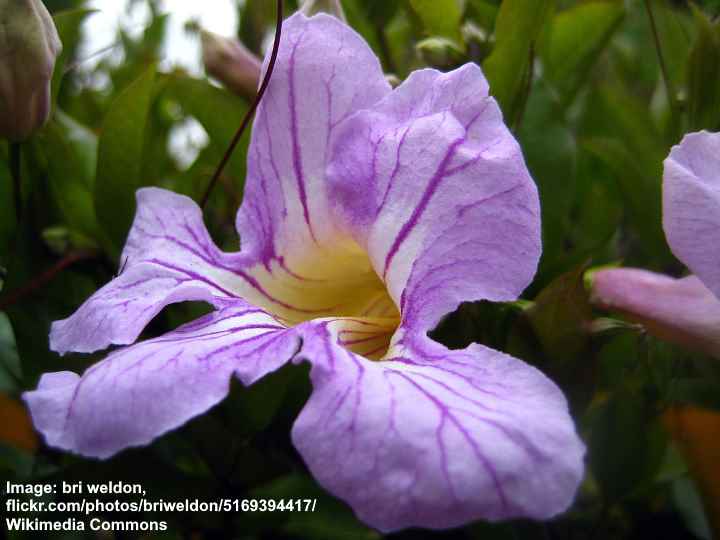
Lavender trumpet vine is a fast growing climber with light purple-lavender flowers
Trumpet vine produces large trumpet flowers that are light lavender and white colors. The glossy green ovate-shaped leaves contrast nicely with the pale purple flowers. You can grow this creeping vine in an evergreen hedgerow to have a spectacular flowering privacy screen. The climbing nature of trumpet vines with their tendrils means they also cover railings, chain fences, and trellises.
The Trumpet vine is a fast-growing tropical plant with its lavender flowers that thrives in zones 9 through 11. The climbing plant quickly reaches up to 25 ft. (7.5 m) tall and can spread up to 20 ft. (6 m) wide.
Purple Flowering Wisteria Vine
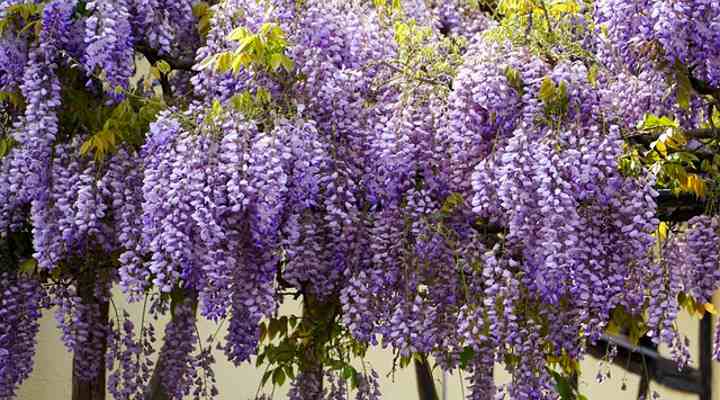
The stunning purple flowers of wisteria climbing plant dangle beautifully over arbors or pergolas
Wisteria is a hardy twining vine with huge clusters of lilac or light purple flowers, hanging like bunches of grapes. The woody wisteria vine climbs by twisting its stems around poles and supports. The stunning violet, white, pink, or purple pendulous bunches of flowers bloom in spring. Wisteria’s vigorous, sturdy growth makes it ideal for growing over large arbors or at the corner of houses.
Climbing wisteria vines thrive in USDA zones 5 through 9 and bloom from spring until summer. Plant in full sun for best results and the sizeable woody vine will grow up to 30 ft. (9 m)
Purple Bougainvillea Vine

Bougainvillea is a flowering climbing plant that thrives in full sun
Bougainvillea is one of the most spectacular tropical flowering vines you can grow in warm climates. The eye-catching purple or pink flowers on this ornamental woody vine are colorful bracts or leaf-like structures. Other colors of bougainvillea include magenta, red, orange, white, or pink.
Bougainvillea vines blossom in full sun in zones 9 through 11. The large shrubby vines spread along walls, climb up trellises, and cover arbors. In some cases, you can train the flowering plants to grow in containers or use them as ground cover in full sun. In colder climates, you can grow bougainvillea in hanging baskets.
Blue Morning Glory (Ipomoea indica)
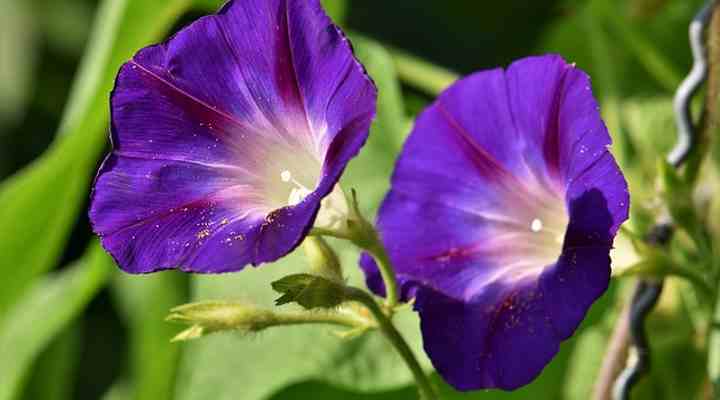
Morning glory is an evergreen perennial climbing plant in warmer climates
Morning glory is a popular twining vine with evergreen foliage, gorgeous trumpet-like flowers, and velvety oval or heart-shaped leaves. You’ll find that many Morning Glory varieties have stunning blue, purple, or pale lilac flowers. Purple types of Morning Glory look spectacular growing over pergolas, fences, walls, or in hedgerows.
The Blue Morning Glory (Ipomoea indica) flowering vine is an evergreen perennial climbing plant that grows in USDA zones 9 through 11.
If you live in colder climates, then the Common Morning Glory (Ipomoea purpurea) is a hardier annual vine with purple flowers that grows in zones 2 through 11. You can plant the climbing vine in full sun, where it will grow up to 10 ft. (3 m) in a season. Or grow the trailing plant in a hanging basket and bring it indoors in winter.
Mandevilla Vine with Purple Flowers
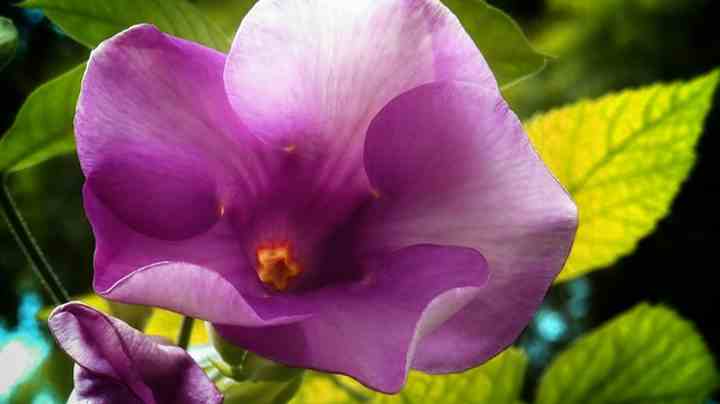
Mandevilla vining plant has flowers in various shades of purple and grows well in full sun
Mandevilla is a tropical vining plant with large, funnel-shaped flowers that bloom in shades of purple, red, white, and pink. The climbing plant is perfect for growing up and over pergolas, trellises, or fences. Mandevilla vines continuously bloom throughout the season and grow well in evergreen hedges or privacy screens.
Because Mandevilla is a tropical climbing vine, it grows as an annual in colder regions. You can plant the fast-growing creeper in garden beds or borders as long as it’s in full sun. Or you can grow this trailing plant in a hanging basket to enjoy its purple flowers indoors.
Japanese Honeysuckle (Lonicera japonica ‘Purpurea’)

Japanese honeysuckle is a climbing plant with fragrant purple-red flowers suitable for partially shaded areas
Also called Purple-Leaf Japanese honeysuckle, this hardy climbing vine has twining stems with lush dark-green foliage and scent-filled purple-red flowers. Japanese Honeysuckle has vigorous growth and is ideal for covering an arbor or growing as a privacy screen. Without support, you can let the creeping vine spread over bare ground for ground cover.
Japanese honeysuckle is a semi-evergreen or evergreen exotic climbing plant for partial shade in zones 4 through 11. In colder climates, you’ll have to cut back the vines before winter. The flowering vine grows between 10 and 30 ft. (3 – 9 m).
Climbing Nasturtium (Tropaeolum ‘Purple Emperor’)

Climbing nasturtium ‘Purple Emperor’ has delicate purple flowers
Climbing Nasturtium has creeping vines with purple, rose-type flowers and broad light-green foliage. The twining stems of Nasturtium will climb up trellises, arbors, mailbox posts, or chain fences. Apart from the light purple flowers of the ‘Purple Emperor’ variety, Nasturtium cultivars have yellow, vibrant red, and bright orange flowers.
Climbing Nasturtium grows as a hardy annual. In USDA zones 7 through 10, you can grow Nasturtium in the ground. In colder climates, this flowering vine grows as an annual.
Boston Ivy (Parthenocissus tricuspidata)

Boston ivy is a climbing plant with colorful foliage throughout the seasons including purple-red
Boston ivy is a vigorous clinging vine with purplish to red leaves and inconspicuous flowers. Boston ivy isn’t a type of climbing plant that stays purple throughout the year. Some kinds of Boston ivy have foliage that starts off purple, then turns green in summer, before becoming crimson red in fall.
Boston Ivy has typical ivy-shaped leaves that turn various shades throughout the seasons. After the ivy flowers, purple berries appear, which you will only see after the climbing deciduous vine loses its leaves.
Boston Ivy can grow to tremendous heights thanks to its sucker vines. It’s not uncommon for the tall vine to reach 50 ft. (15 m) or more.
Sweet Pea (Lathyrus odoratus)
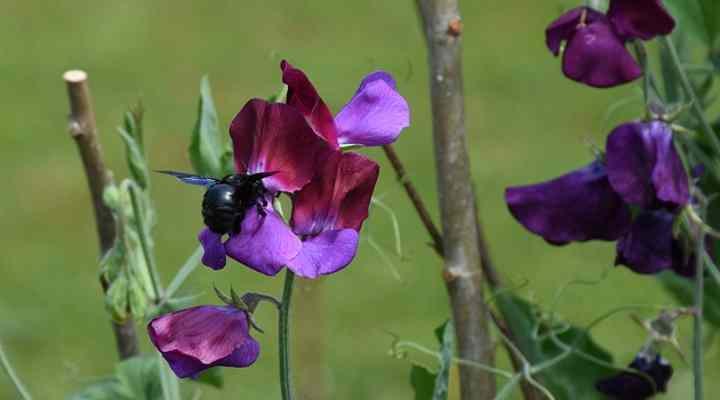
Sweet pea is an annual climbing vine that thrives in full sun
Sweet Pea is a beautiful annual climbing vine with flowers in shades of purple, pink, orange, red, and lilac. Depending on the variety, sweet pea climbing plants can grow between 6 and 8 ft. (1.8 – 2.4 m) tall. To help them climb high, it’s necessary to intertwine or support the delicate stems.
If you want to enjoy masses of Sweet Pea flower clusters and their beautiful scents, grow the flowering vines in full sun. Sweet Pea produces the best flowers in mild climates and blooms from spring to fall.
Climbing Fuchsia
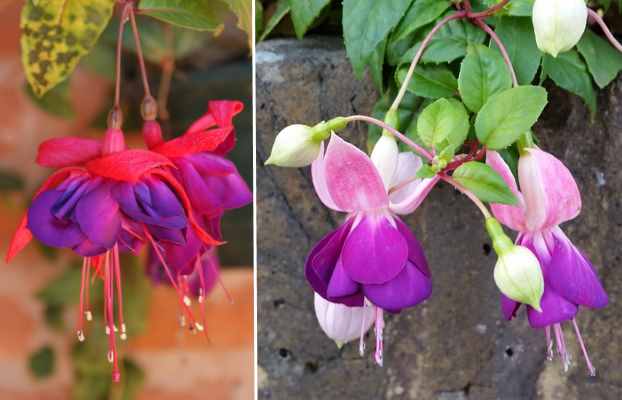
Fuchsia is a fast growing climber with attractive flowers in various shades of red, pink and purple
Many fuchsia varieties are shrubby climbing vines with purple, pink and red flowers. Fuchsia is a vigorous climber that blooms from spring until the fall with a mass of dangling purple-pink or purple-red, bell-shaped flowers. The fuchsia vine leaves are dark green, ovate with serrated margins.
Some fuchsia cultivars are more sun tolerant than others and require moist but well-draining soil. Climbing fuchsia plants grow up to 5 ft. (1.5 m) in a single season and reach a mature height of 10 ft. (3 m). Hardy fuchsias grow well in USDA zones 9 through 11.
The decorative purple vining fuchsia plants are ideal for back-of-border plantings and will also work well covering trellises, chain-link fences, or as a flowering privacy screen. You can also grow species of fuchsias as a flowering hanging basket plant.
Butterfly Pea (Centrosema molle)
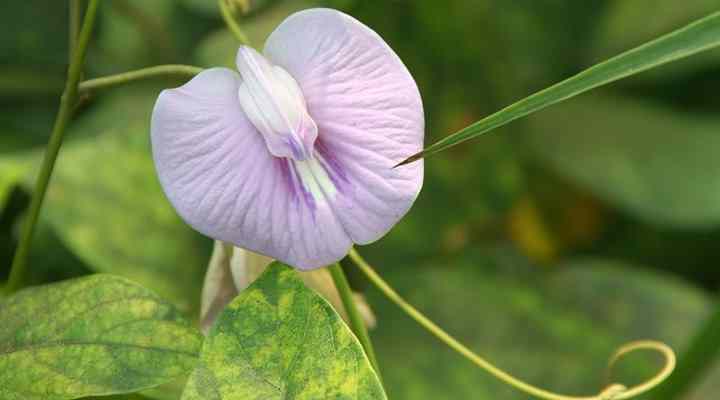
Butterfly pea is a climbing plant with flowers that have delicate pale violet petals and dark purple veins. The thin stems of Butterfly Pea need support to grow upward, and it’s best to grow the dainty flowers as part of a flowering summer hedgerow. Butterfly pea vines are annuals that grow up to 18” (45 cm) tall.
Chocolate Vine (Akebia quinata)
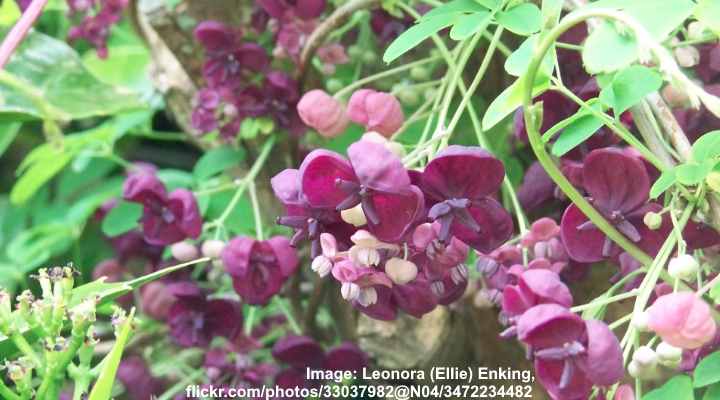
Chocolate vine is a deciduous woody climbing plant with brownish-purple flowers and large palmately compound leaves. The purplish flowers appear on the vine in early spring. Also called the Five-Leaf Akebia, this fast-growing woody vine has purple fruit in the shape of a sausage.
Chocolate vines grow between 25 and 60 ft. (7.5 – 18 m) tall and thrive in full sun in USDA zones 5 through 8.
Garlic Vine (Mansoa alliacea)

Garlic vine is a climbing plant that produces elegant purple to light lilac flowers. As an ornamental evergreen creeping plant, the garlic vine grows up to 8 ft. (2.5 m) tall. The lavender garlic vine flowers bloom twice a year. Also, the leaves give off a garlic odor when you crush them.
Garlic vines grow in the ground in zones 9 and above. You can also grow garlic vines indoors in pots if they get enough sunlight to bloom.
Bittersweet Nightshade (Solanum dulcamara)
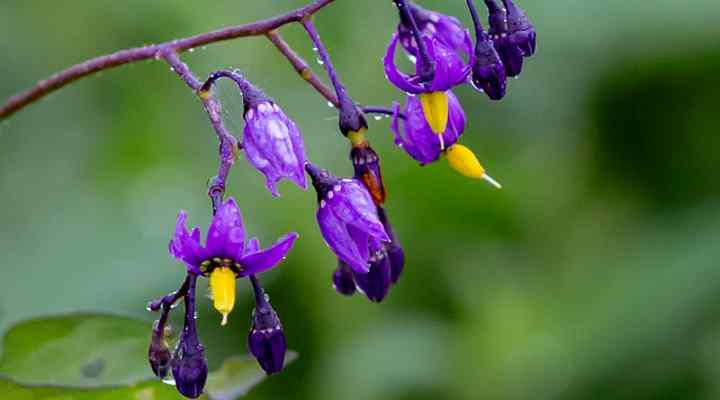
Bittersweet nightshade is a species of creeping vine in the potato genus Solanum. As a perennial vine, Bittersweet Nightshade produces clusters of purple flowers made up of 5 recurved, pointed petals that form the shape of a star. The unusual purple flowers have a protruding yellow stamen.
The large dark green arrow-shaped leaves have a hint of purple, giving the vine’s foliage a lush appearance.
Bittersweet nightshade is a climbing vine that grows up to 13 ft. (4 m) tall. You can grow bittersweet nightshade vines in gardens in zones 4 through 8. However, it’s essential to remember that all parts of the vine are poisonous.
Discover the most beautiful red flowering vines.
Related articles:
